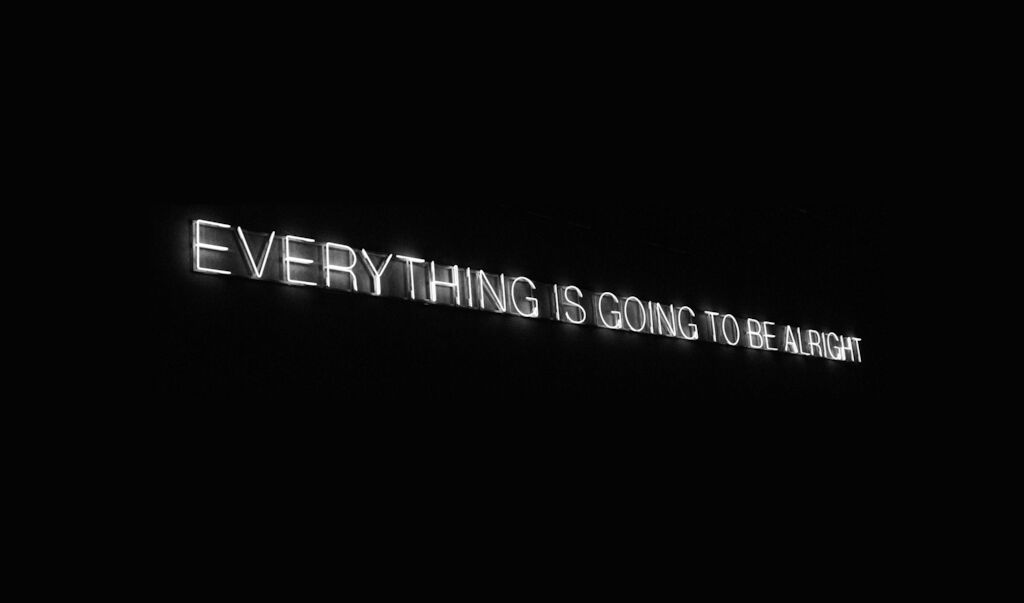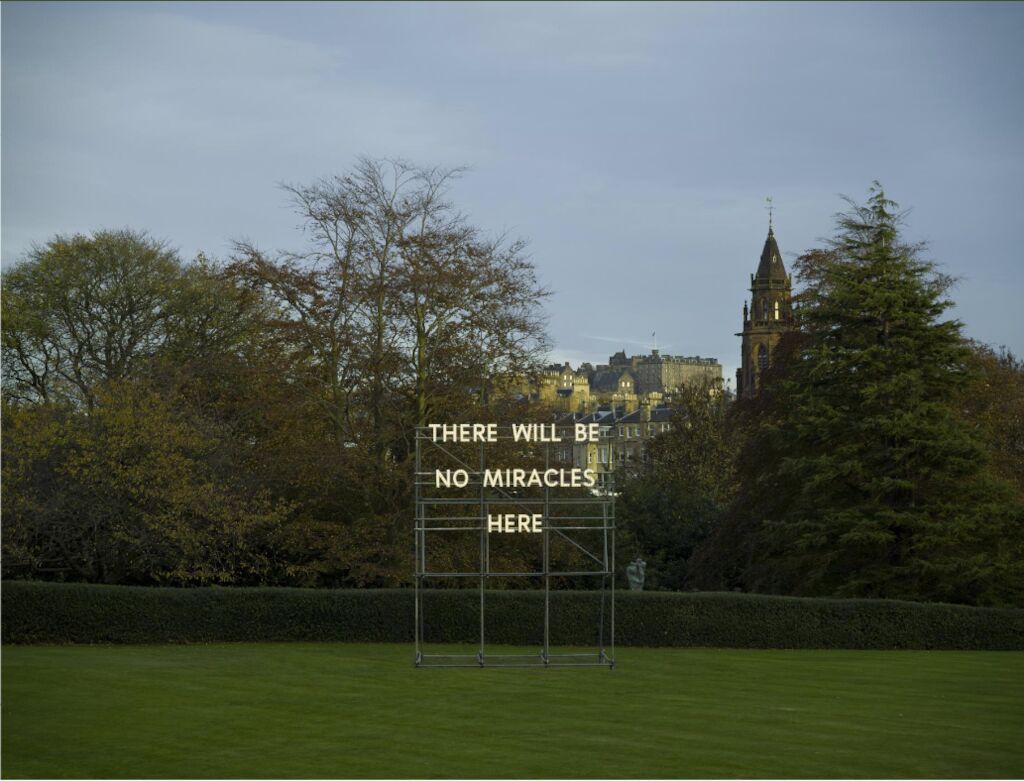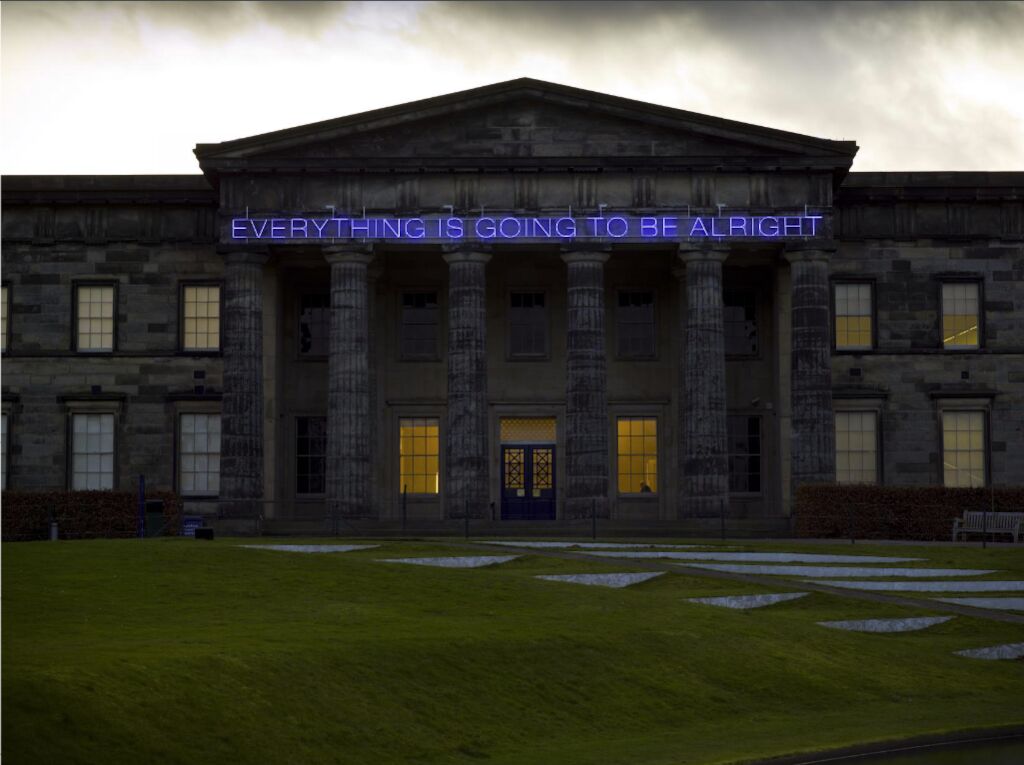In Edinburgh I saw two neon signs at the Scottish National Gallery of Modern Art.
Everything is going to be alright. There will be no miracles here.

Brand strategy in the eco-anxiety age
In Edinburgh I saw two neon signs at the Scottish National Gallery of Modern Art.
Everything is going to be alright. There will be no miracles here.


A dynamic tension fuses these two messages – a desire for everything to work out well, and a nagging fear that it won’t. This clash of wishes versus reality reminds me of an emerging social dynamic, in which a universal need for a hopeful future is crashing against a formidable barrier: climate crisis. The fallout from this collision is eco-anxiety.
Societal-wide eco-anxiety is now a studied subject. In 2017, the American Psychological Association (APA) issued a report on climate change’s rising impact on mental health, defining eco-anxiety as “a chronic fear of environmental doom.” A 2018 Yale Climate Change Communication study found that 70% of Americans are “worried” about climate change, with 59% feeling “helpless.”
Current headlines and scientific reports amplify these emotions. The common theme is: If we don’t radically and quickly transform the way we grow food, use land, transport goods, and power our economies, there will be an irreversible ecosystem breakdown and mass extinction. It’s unsettling, even paralyzing, which can lead to either collective denial or, as a growing body of evidence suggests, widespread anxiety.
As much as we’d like this condition to disappear, there’s no pill for eco-anxiety. There are genuine and formidable challenges ahead, which will require a unified global effort of nations, industries, and communities – what some are calling a task akin to waging a World War Zero. Words are not enough. It’s time for meaningful action.
Part of our job as brand strategists is to identify such societal trends and needs. This allows us to shape our clients’ brand identities to meet those needs, which in turn help sharpen design and messaging, raise awareness, and change perception.
Using these techniques, we have an opportunity to dig down to the root causes of eco-anxiety by helping steer businesses toward real climate action. Applying our methods through the filter of sustainability not only enhances the meaning and impact of our work, it encourages industry actions that can lead to positive systemic change.
There’s a strong business case for companies to be climate-action players: their customers want it. 81% of global respondents feel strongly that companies should help improve the environment. Furthermore, sustainable/ethical business practices are now the second biggest driver of customer loyalty (more than brand name and brand mission).
Now that we’ve identified a social phenomenon and a business driver, let’s look at how brand strategy can lead the way to substantive climate action.
Here are four areas in which brand strategy can influence and advance climate action among businesses.
Craft a purpose that signals change and drives transformation toward climate action.
For those companies who are qualified and ready to take positive climate action, a newly articulated purpose can powerfully illustrate the level of their commitment and give management a lever to drive organizational change. It’s about framing the discussion, transforming perceptions, and creating opportunity. Take Neste, for example, a Finnish company whose reformed purpose spotlights their shift from crude-oil refinery to manufacturer of renewable fuels: "Creating a healthier future for our children"
It’s a purpose that’s big and intimate, ambitious and humble. It symbolizes an actual sustainability program – renewable fuels – and holds the company accountable for being responsible and progressive. Neste is now listed as the 3rd most sustainable company in the world.
Alter product offering and supply chain.
A climate-action purpose needs to be backed by meaningful actions that reflect the company’s new direction. While we as brand strategists aren’t necessarily in a position to dictate operational strategy, we can counsel clients on emerging opportunities, such as the adoption of circular economy principles. ABInBev, the world’s largest brewer, turned climate action into a business strategy that includes a transformed supply chain of smarter agricultural practices, water stewardship, renewable energy sourcing, and circular packaging. As ABInBev expressed the shift, “sustainability isn’t just part of our business, it is our business.”
Identify and form beneficial collaborations.
Climate action will only be effective as a widespread, collaborative effort. Brand strategists can identify partnerships for clients that will increase positive impact and authenticate their efforts to integrate sustainability. For example: - Hyundai Motor Group joined forces with the global Hydrogen Council to help realize the infrastructure of a clean energy, “Hydrogen-Society” vision. - Unilever and JD Logistics are working together to advance sustainable solutions on the supply chain. - WWF and Sky have teamed up to develop new technologies and innovations to eradicate single-use plastics from supply chains and stop plastic from ending up in the ocean.
A World War Zero campaign requires alliances, not silos. More partnerships are waiting to be born. We have to find them – among NGOs, startups, even competitors – and thoughtfully bring them to the table of strategic discussions.
Involve customers and the public.
Some businesses have the potential to fuel a movement. This can happen when we match the company purpose with a societal trend that strikes a powerful chord in the public discourse. Patagonia’s purpose, “We’re in business to save our home planet,” has a platform to amplify its effects. They directly involve their customers and the public at large with the Patagonia Action Works, a digital hub connecting individuals to environmental organizations. On Black Friday 2019, Action Works invited people to “help our home planet” by donating to grassroots environmental groups. Patagonia promised to match public donations. The effort generated $20 million in two weeks, an indicator of the exponential power of commitment + action + partnerships + amplification.
Even if there are no miracles here, there can be action. We can contribute. We can instigate change. It’s no longer about just shaping perceptions, or even about mitigating eco-anxiety. If we do our part as brand strategists to point the way for our clients to become climate-action players, we truly have a chance to help create a world that is everything we hope it can be.
_Joshua Englander is a strategy partner at MetaDesign in Berlin. You can contact him at joshua.englander@metadesign.com.
_Museum of Modern Art images:
- nationalgalleries.org/art-and-artists/106670/work-no-975-everything-going-be-alright